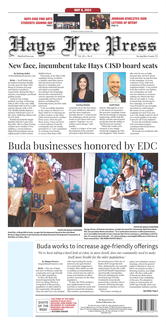Paulina “Polly” Robles from Lehman High School, along with her nine student research colleagues, stands in front of the Hobby-Eberly Telescope at the McDonald Observatory, the fourth largest telescope in the world. The students recently spent a week at the observatory as part of a University of Texas at Austin project on dark energy. (Photo by Kim Hilsenbeck)
by KIM HILSENBECK
Ten Central Texas high school students, including Paulina “Polly” Robles from Lehman High School, recently spent a week at the McDonald Observatory in west Texas. But this was no summer sleep away camp.
These young adults were part of an astronomical research study of one of the biggest scientific mysteries today: dark energy. Astronomers know the expansion of the universe has not been slowing as originally theorized. But the cause, while unknown, is called dark energy.
The students also shared their experiences using social media.
University of Texas at Austin post-doctoral researcher Keely Finkelstein is running the project, along with astronomer Irina Marinova and several area teachers including Sherre Boothman of Lehman High School.
“This workshop is a unique experience for these students,” Finkelstein said. “They are getting a first-hand look and hands-on experience of what it’s like to be a research astronomer.”
By day, the students learned how telescopes work and how to collect data. They also attended talks on various topics in astronomy and on sharing their experiences with their peers through social media outlets. At night, they used research-grade telescopes under the darkest night skies of any observatory in the continental United States.
“It’s really great to meet new people who have the same interests as you and are diving into what it means to be an astronomer,” Polly said. “The whole experience has been amazing.”
Finkelstein said the young researchers used real data from the MONET telescope at the observatory and went through the full process of research, including observations and data analysis.
“They get to experience all aspects of observing, both the exciting parts and the not-so-glamorous parts,” she said.
Equally important, said Marinova, “is that the students are able to interact in an informal setting with the scientists and engineers doing research and maintaining the observatory. They are able to talk to them one-on-one about what their jobs entail and the science that they do.”
This student research experience is a pilot program for a larger one still in the planning stages, according to Finkelstein. The aim is to involve high school students in one of McDonald Observatory’s largest, most important research efforts: the Hobby-Eberly Telescope Dark Energy Experiment (HETDEX). The project seeks to understand why the universe is expanding faster all the time, a fact discovered by two teams of astronomers in 1998 which recently garnered them the Nobel Prize in physics.
University of Texas at Austin astronomy professor Karl Gebhardt is the project scientist for HETDEX.
“There are two aspects to this student project,” Gebhardt said. “One is to eventually upgrade the McDonald visitors center with a whole new exhibit [on dark energy] and we want to bring high school students in on the Facebook and YouTube stuff – they know how to make an online presence.”
The second aspect is getting students involved in actual HETDEX research. “What we want is for them to take images of fields we’re observing at the same time on HET [the Hobby-Eberly Telescope]. We’ll use the students’ imaging data to calibrate the HET data.”
To get those simultaneous images, he says, is going to take “a lot of nights and a lot of time – that’s where the high school students come in. And we hope to excite them about science at the same time.”




